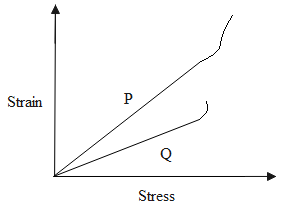
In plotting stress versus strain curves for two materials P and Q, a student by mistake puts a strain on the y-axis and stress on the x-axis as shown in the figure. Then the correct statements(s) is (are)

A. P has more tensile strength than Q
B. P is more ductile than Q
C. P is more brittle than Q
D. The Young’s modulus of P is more than that of Q

Answer
450.9k+ views
Hint: The stress-strain curve for a material gives the slope equal to that of Young’s modulus of that material. And, the slope is the angle of tan function. Even the modulus of rigidity can be defined using this slope. So, using these terms, we will answer this question.
Formula used:
Complete step by step answer:
The stress-strain curve for a material gives the slope equal to that of Young’s modulus of that material. And, the slope is the angle of tan function.
More the Young’s modulus more will be the tensile strength.
As Young’s modulus of the material Q is more than that of the material P, thus, the tensile strength of Q is more than that of the material P.
The modulus of rigidity is the ratio of the tangential stress to the shearing strain. The formula that defines the relationship between the modulus of rigidity, stress and strain is given as follows.
Where
Considering a particle value of stress and strain, we get to know that, the stress of the material P is more than that of the material Q. Thus, the length of the material P can be increased by a larger amount than Q, for the same amount of applied strain. Therefore, we can say that the material P is more ductile than the material Q. And at the same time, we can say that, the material P is less brittle than the material Q, because, P elongates more before it breaks than Q.
So, the correct answer is “Option B”.
Note: This is neither a tricky nor simple question. The curves are drawn to make the question a bit complicated. We only need the value of the slope of the angle made by the stress-strain curve to solve this type of question.
Formula used:
Complete step by step answer:
The stress-strain curve for a material gives the slope equal to that of Young’s modulus of that material. And, the slope is the angle of tan function.
More the Young’s modulus more will be the tensile strength.
As Young’s modulus of the material Q is more than that of the material P, thus, the tensile strength of Q is more than that of the material P.
The modulus of rigidity is the ratio of the tangential stress to the shearing strain. The formula that defines the relationship between the modulus of rigidity, stress and strain is given as follows.
Where
Considering a particle value of stress and strain, we get to know that, the stress of the material P is more than that of the material Q. Thus, the length of the material P can be increased by a larger amount than Q, for the same amount of applied strain. Therefore, we can say that the material P is more ductile than the material Q. And at the same time, we can say that, the material P is less brittle than the material Q, because, P elongates more before it breaks than Q.
So, the correct answer is “Option B”.
Note: This is neither a tricky nor simple question. The curves are drawn to make the question a bit complicated. We only need the value of the slope of the angle made by the stress-strain curve to solve this type of question.
Latest Vedantu courses for you
Grade 11 Science PCM | CBSE | SCHOOL | English
CBSE (2025-26)
School Full course for CBSE students
₹41,848 per year
Recently Updated Pages
Master Class 9 General Knowledge: Engaging Questions & Answers for Success

Master Class 9 English: Engaging Questions & Answers for Success

Master Class 9 Science: Engaging Questions & Answers for Success

Master Class 9 Social Science: Engaging Questions & Answers for Success

Master Class 9 Maths: Engaging Questions & Answers for Success

Class 9 Question and Answer - Your Ultimate Solutions Guide

Trending doubts
State and prove Bernoullis theorem class 11 physics CBSE

Who built the Grand Trunk Road AChandragupta Maurya class 11 social science CBSE

1 ton equals to A 100 kg B 1000 kg C 10 kg D 10000 class 11 physics CBSE

State the laws of reflection of light

One Metric ton is equal to kg A 10000 B 1000 C 100 class 11 physics CBSE

Difference Between Prokaryotic Cells and Eukaryotic Cells




